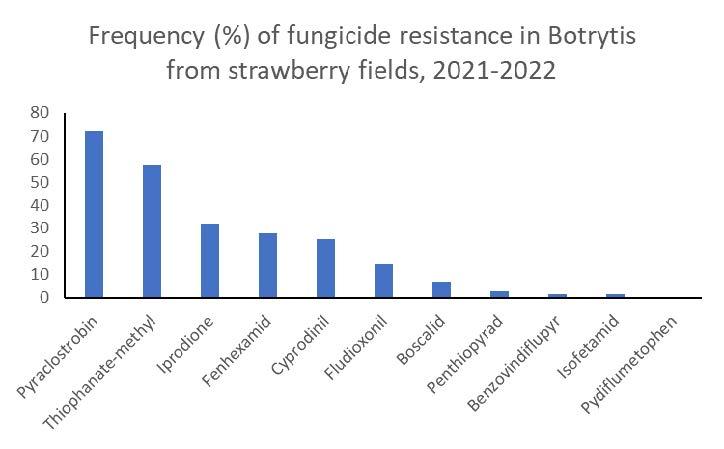Fungicide Resistance in Botrytis from Strawberry Fields, 2021-2022 Season

Strawberry Botrytis fruit rot, also called gray mold (fig 1) , is a common disease that typically drives fungicide sprays throughout a season. Flowers are considered the gateway for the pathogen, and some flower infections can stay latent until fruit ripening while some may show up earlier at green berry stage under wet and cool conditions. The disease is relatively easy to manage with fungicides, but resistance has been a concern for most single-site fungicides labelled for gray mold control. During the 2021-2022 season, we obtained and processed a total of 75 Botrytis isolates originated from flowers from 8 commercial farms in the region (most of them are in Mary-land). We tested for resistance to thiophanate-methyl (Topsin M), pyraclostrobin (one of two components of Pristine or Merivon), cyprodinil (one of two components of Switch), fenhexamid (Elevate), iprodione (Rovral), boscalid (major botryticide component of Pristine), fludioxonil (major botryticide component of Switch), penthiopyrad (Fontelis), benzovindiflupyr (Aprovia), isofetamid (Kenja), and pydiflumetophen (one of two components of Miravis Prime). Except for Aprovia, all products (in parenthesis) are labelled for strawberry production.
Frequencies of resistance to pyraclostrobin and thiophanate-methyl remain to be high; however, the frequencies were unexpectedly lower than previous monitoring data which exceeded 85% for both fungicides. This could be explained by generally infrequent use of Topsin M and Pristine in recent years and possible fitness costs associated with the resistant populations. Frequencies of resistance to iprodione, fenhexamid, and cyprodinil remain largely the same as previous data; and use of these fungicides is not advisable unless resistance is tested. Fungicide efficacy could be compromised by 50% only if 10% of isolates in the field are resistant. Resistance to fludioxonil seems to be on a rise. Switch, containing fludioxonil, has been commonly used in strawberry production due to its excellent efficacy against both Botrytis and anthracnose fruit rot, now it is also recommended for the new Neopestalotiopsis disease. The increased reliance on fludioxonil may have led to the increased resistance issue in Botrytis. The use of fludioxonil thus needs to be cautious; no more than two applications per season and always tank mix with Captan or Thiram when using it. It is noteworthy that Switch and Miravis Prime both have fludioxonil, so use each product once per season means two applications of fludioxonil. On the bright side, frequencies of resistance to SDHI fungicides remain to be low, especially for Fontelis, Aprovia (not labelled for strawberries), Kenja, and Miravis Prime. Luna fungicides within the same chemical group are not included in the test, but resistance frequency should also be low and comparable with other SDHIs.
In general, a good resistance management strategy involves use of multi-site fungicides such as Captan or Thiram as a backbone and avoidance of unnecessary sprays of single-site fungicides. Single-site fungicides may be used under high disease pressure (susceptible growth stage plus disease favorable weathers), and it is better to tank-mix with a multi-site fungicide.
This article appears in September 2022, Volume 13, Issue 6 of the Vegetable and Fruit News.
